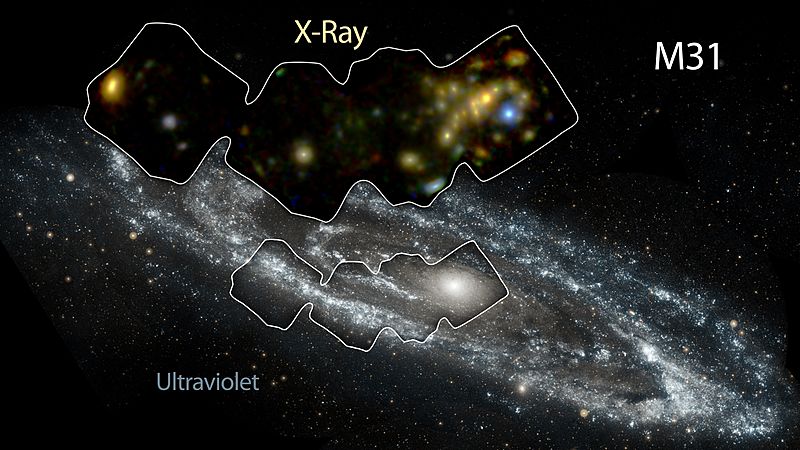Image: PIA20061 - Andromeda in High-Energy X-rays, Figure 1

Description: PIA20061: Andromeda in High-Energy X-rays - released January 5, 2016 http://photojournal.jpl.nasa.gov/catalog/PIA20061 NASA's Nuclear Spectroscope Telescope Array, or NuSTAR, has imaged a swath of the Andromeda galaxy -- the nearest large galaxy to our own Milky Way galaxy. NuSTAR's view (inset) shows high-energy X-rays coming mostly from X-ray binaries, which are pairs of stars in which one "dead" member feeds off its companion. The dead member of the pair is either a black hole or neutron star. NuSTAR can pick up even the faintest of these objects, providing a better understanding of their population, as a whole, in Andromeda. The findings ultimately help astronomers gather clues about similar objects in the very distant universe. The background image of Andromeda was taken by NASA's Galaxy Evolution Explorer in ultraviolet light. Andromeda is a spiral galaxy like our Milky Way but larger in size. It lies 2.5 million light-years away in the Andromeda constellation. NuSTAR is a Small Explorer mission led by the California Institute of Technology in Pasadena and managed by NASA's Jet Propulsion Laboratory, also in Pasadena, for NASA's Science Mission Directorate in Washington. The spacecraft was built by Orbital Sciences Corporation, Dulles, Virginia. Its instrument was built by a consortium including Caltech; JPL; the University of California, Berkeley; Columbia University, New York; NASA's Goddard Space Flight Center, Greenbelt, Maryland; the Danish Technical University in Denmark; Lawrence Livermore National Laboratory, Livermore, California; ATK Aerospace Systems, Goleta, California, and with support from the Italian Space Agency (ASI) Science Data Center. NuSTAR's mission operations center is at UC Berkeley, with the ASI providing its equatorial ground station located at Malindi, Kenya. The mission's outreach program is based at Sonoma State University, Rohnert Park, California. NASA's Explorer Program is managed by Goddard. JPL is managed by Caltech for NASA. For more information, visit http://www.nasa.gov/nustar and http://www.nustar.caltech.edu/. - At approximately 2.5 million light-years away, the Andromeda Galaxy, or M31, is our Milky Way's largest galactic neighbor. The entire galaxy spans 260,000 light-years across - a distance so large, it took 10 GALEX images stitched together to produce this view of the galaxy next door. The wisps of blue making up the galaxy's spiral arms are neighborhoods that harbor hot, young, massive stars. Meanwhile, the central orange-white ball reveals a congregation of cooler, old stars that formed long ago. Andromeda is so bright and close by that it is one of only three galaxies that can be spotted from Earth with the naked eye. This view is two-color composite, where blue represents far-ultraviolet light, and red is near-ultraviolet light.
Title: PIA20061 - Andromeda in High-Energy X-rays, Figure 1
Credit: http://photojournal.jpl.nasa.gov/figures/PIA20061_fig1.jpg
Author: NASA/JPL-Caltech/GSFC
Usage Terms: Public domain
License: Public domain
Attribution Required?: No
Image usage
The following page links to this image:

